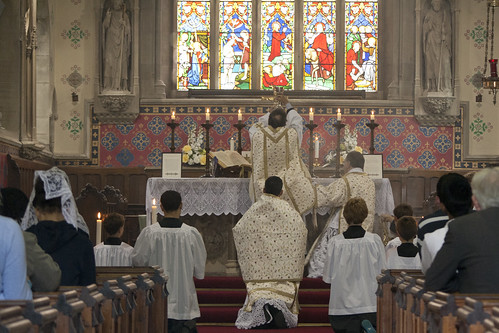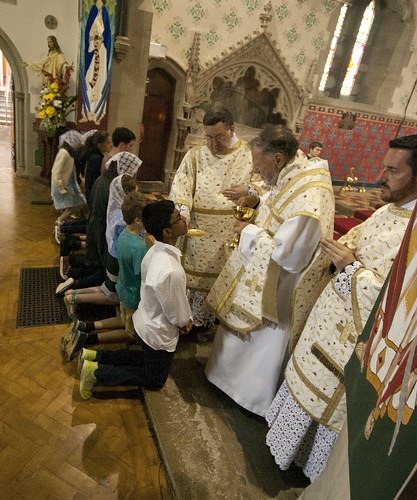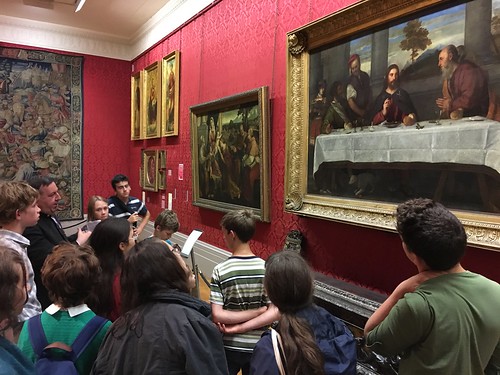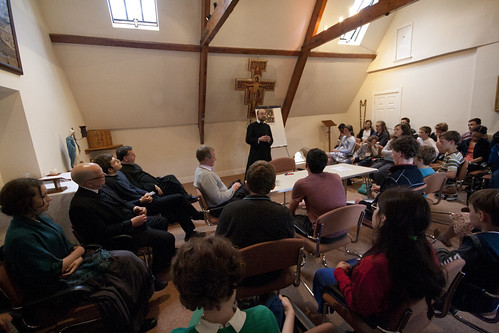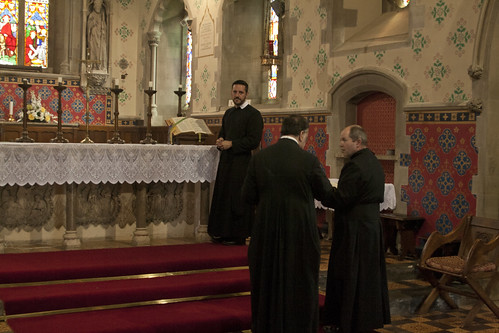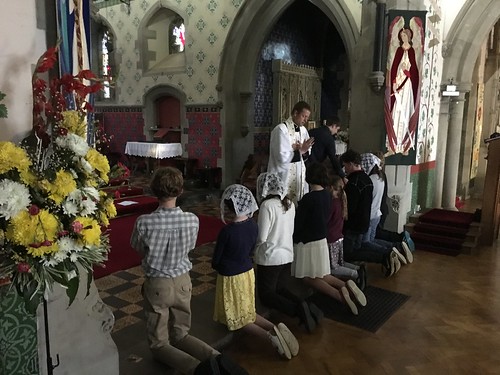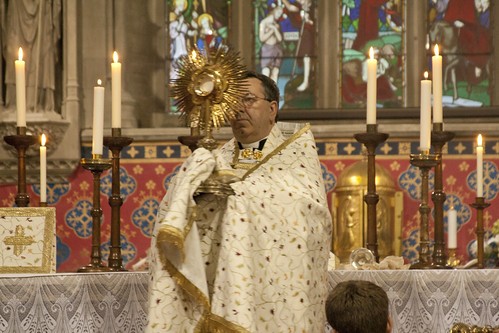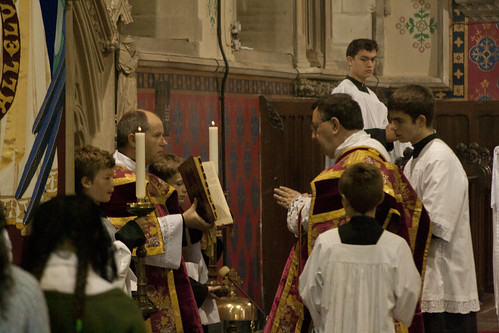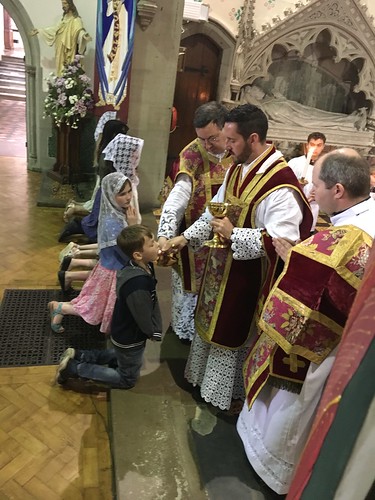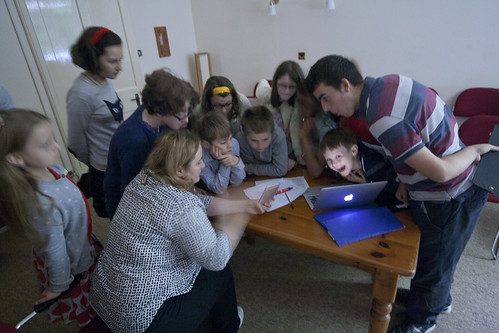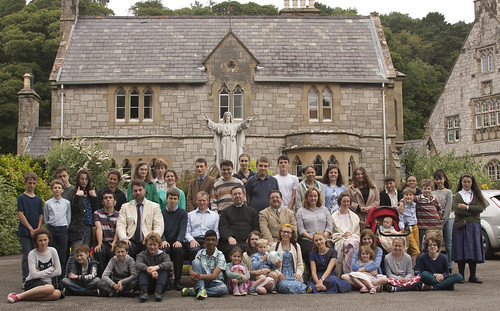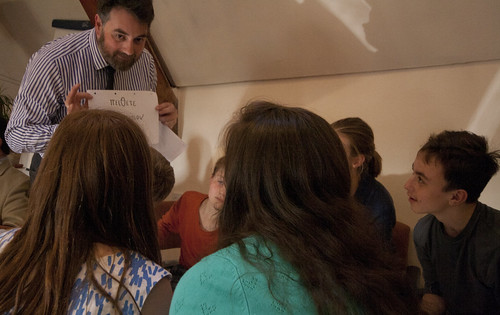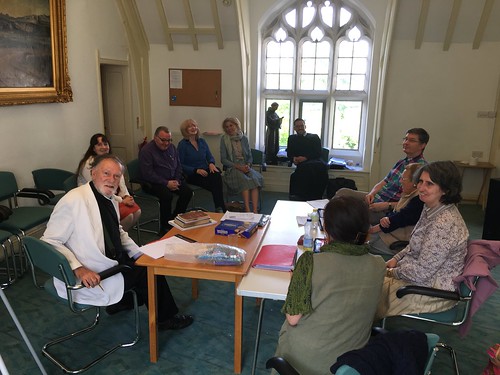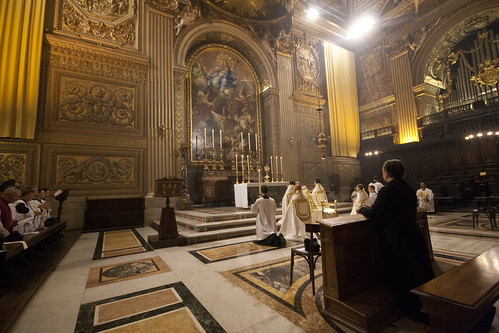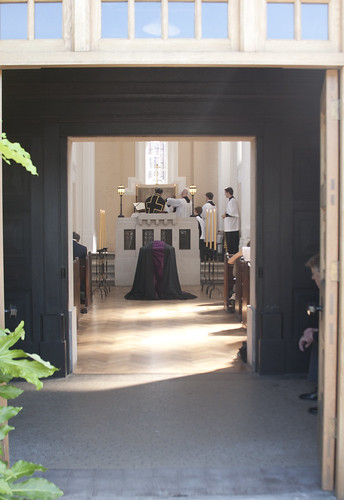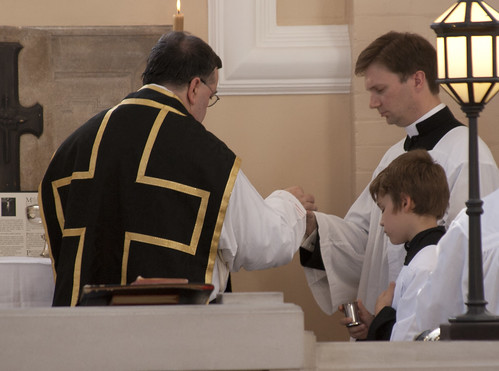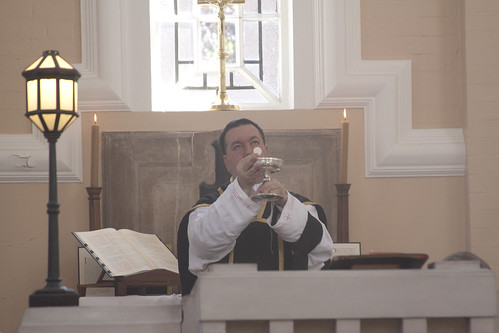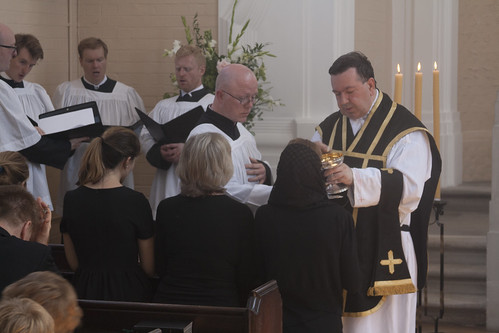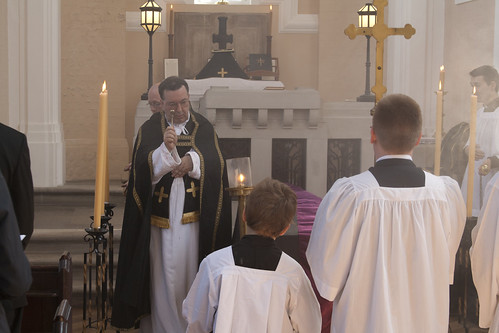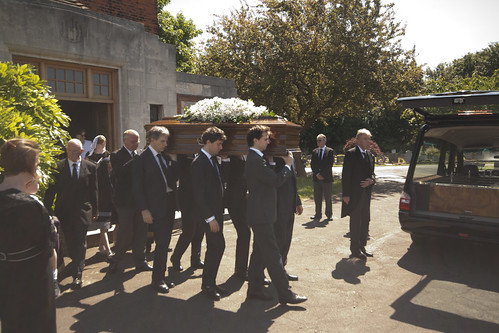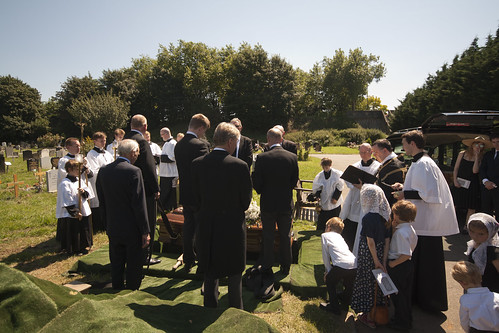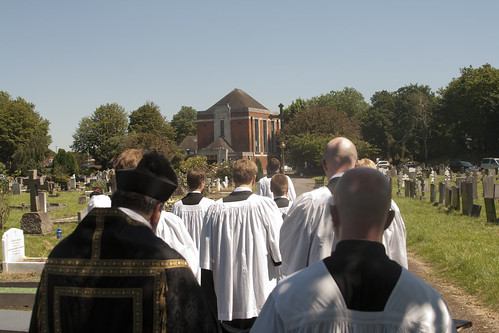Chairman's Blog
SCT Summer School 2016: photo essay
This was the tenth Summer School run by the St Catherine's Trust. Numbers have been increasing over the last several years, and we are now close to capacity with 35 students.
Fr John Hunwicke, the celebrant above, and Fr Richard Bailey of the Manchester Oratory, were present for most of the week teaching the Latin Mass Society's residential Latin course, with Fr Andrew Southwell, the Summer School's chaplain.
One highlight of the week was a visit to the Walker Art Gallery in Liverpool, which has an impressive collection of Medieval and Renaissance art, and some superb Pre-Raphaelites.
Fr Anton Guziel of the Birmingham Oratory gave us an evening talk, on St Philip Neri.
One of the students on the Latin course was a priest from Dublin, Fr Adrian Kieran, who learnt the role of sub-deacon at High Mass as a bonus.
One of the optional activities was sewing. The project this year was embroidered brown scapulars.
Another evening talk was given by the recently ordained Fr James Mawdsley FSSP, was is now based in Warrington. He gave us 'first blessings'.
The end of school quiz. Yes, they learnt a bit of Greek.
The Latin Course students with their tutors for a final feedback discussion.
Support the work of the LMS by becoming an 'Anniversary Supporter'.
The results of persecution
Reposted from October 2009. The coming persecution, whether by militant secularists or Islamists, will not be a lovely time of growth and development. It will be horrible.
----------------
Last night I went to the annual Craigmyle Memorial Lecture, hosted by Jim Dobbin MP on behalf of the Catholic Union and given in Portcullis House. This year the speaker was HE Francis Campbell, the first Catholic to be Britain's Ambassador to the Holy See, and still in office. He gave a thoughtful talk on Pope Benedict's conception of Europe and secularism.
An interesting discussion took place during the questions about the effect of persecution on the Church. One questioner was saddened and disillusioned that the church in the Czech Republic, having been active in opposing the Communists, had, since Communism fell, become rather an insignificant force in what is said to be the most secular country in Europe. Another questioner suggested that the reason for the decline in the Czech church was that it was no longer being persecuted.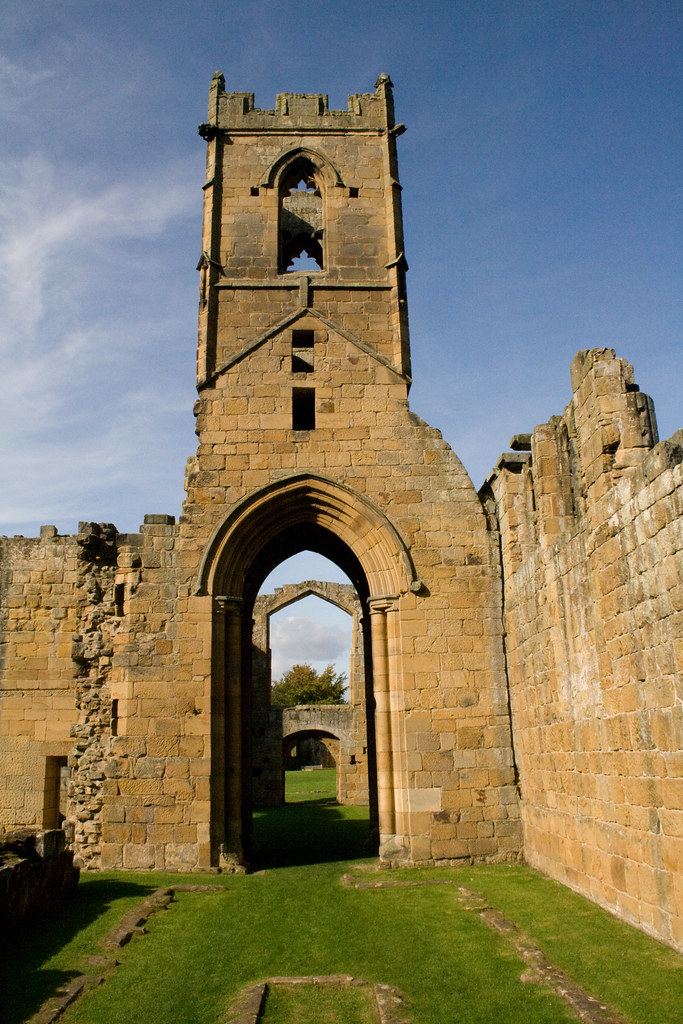
Mount Grace Priory, a Carthusian house (more photos).
Having been to Yorkshire recently I can show exactly what persecution, when at all effective, usually does to the Church. It makes a ruin of its institutions, and most of its members apostatize. Of the Yorkshire Cistercians in the four great Abbeys there only one, George Lazenby of Jervaulx, gave his life for refusing to assent to the manifestly absurd claim (which even Queen Elizabeth did not revive) that the monarch was the Head of the Church.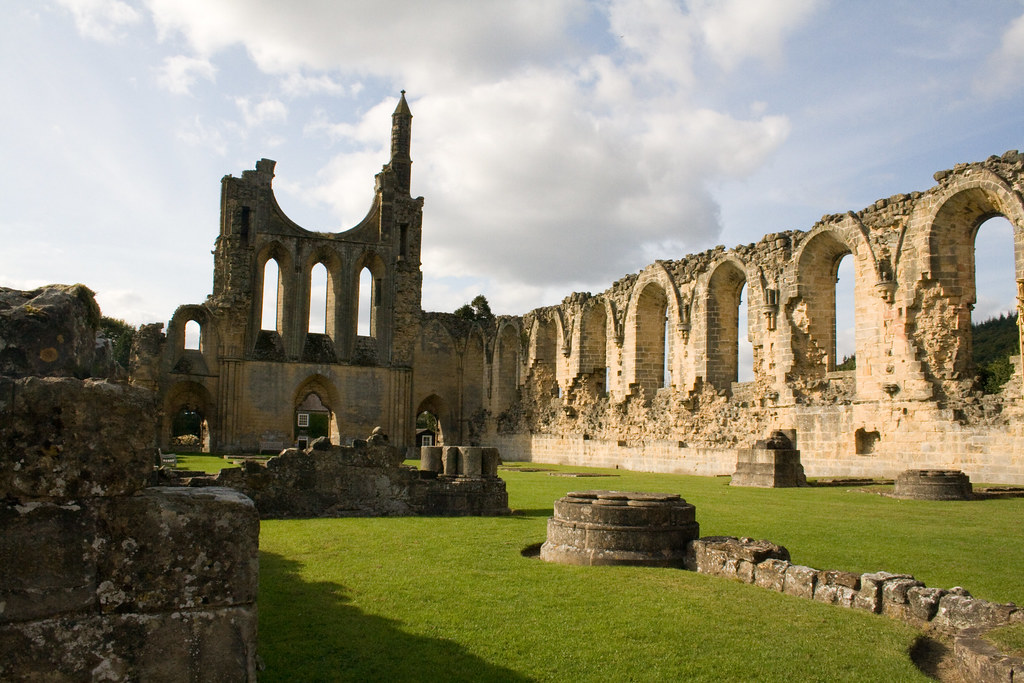
Byland Abbey, Yorkshire, Cicsterian (more photos).
In Poland the result of the persecution, to leave aside the most obvious, the horrific sufferings of Catholics under the Nazis and Communists, has been the agonising on-going revelations of the treachery of one after another respected prelate. The effect on the minds of the ordinary people of more than a generation of unquestioned anti-Catholic propaganda will take at least another generation to undo, and probably far longer.
Yes, certainly persecution gives us martyrs, but anyone who thinks that it unites the Church clearly hasn't read any history: the early Church was riven by heresy during persecution; persecuted English Catholics under persecution were bitterly divided about both strategy and leadership, divisions cruelly exploited by the persecutors.
And yet there are still people looking forward to what appears to be coming - a increasingly shrill persecution of Catholicism by the British state - as if to a lovely warm bath. But it won't be lovely. It will be horrible. Without institutions, whether they be adoption agencies, charities, or schools, the Church is maimed: she cannot spread the gospel or undertake her characteristic works of love towards all effectively. So the first thing which will happen is that the Church will cease to be able to make visible to society at large what the gospel means in practice.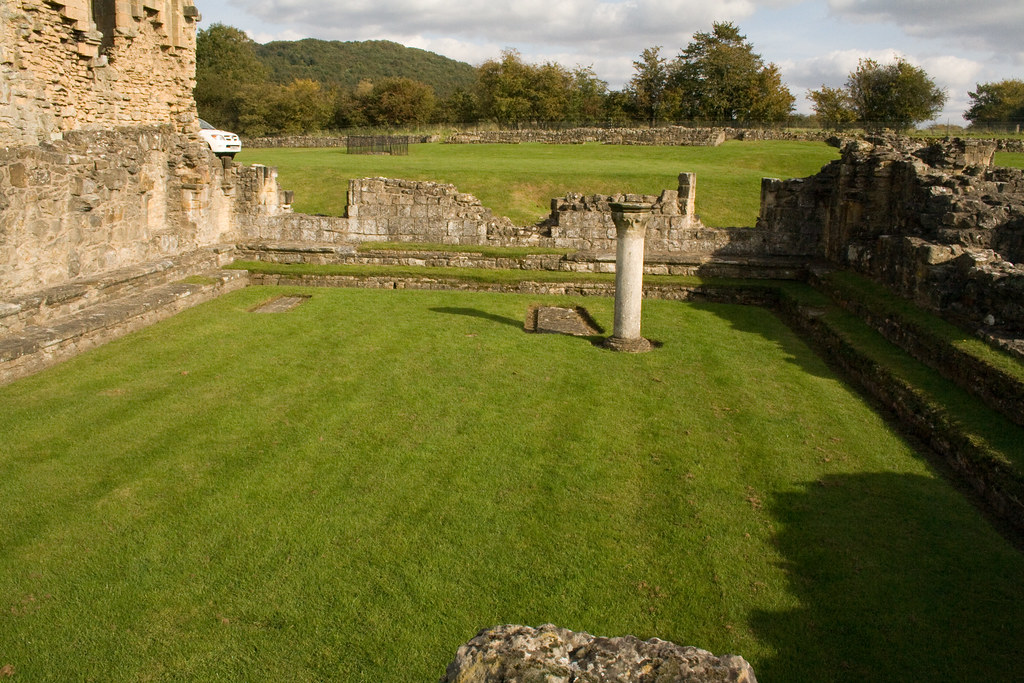
Byland Abbey Chapter House.
The next thing that will happen is apostasy. Lukewarm Catholics who find professing their faith embarrassing or even a danger to their jobs will cease to do it, and will fall away from the faith. Fervent Catholics will be more and more cautious about doing it, and will tend to become lukewarm. No one will hear Catholics witnessing to their faith and conversions will fall.
After that we can expect increased internal divisions. Catholics always have their disagreements, but a situation of chronic pressure from outside creates a feeling of desperation, which is expressed in ill-considered but emotional support for conflicting plans and leaders.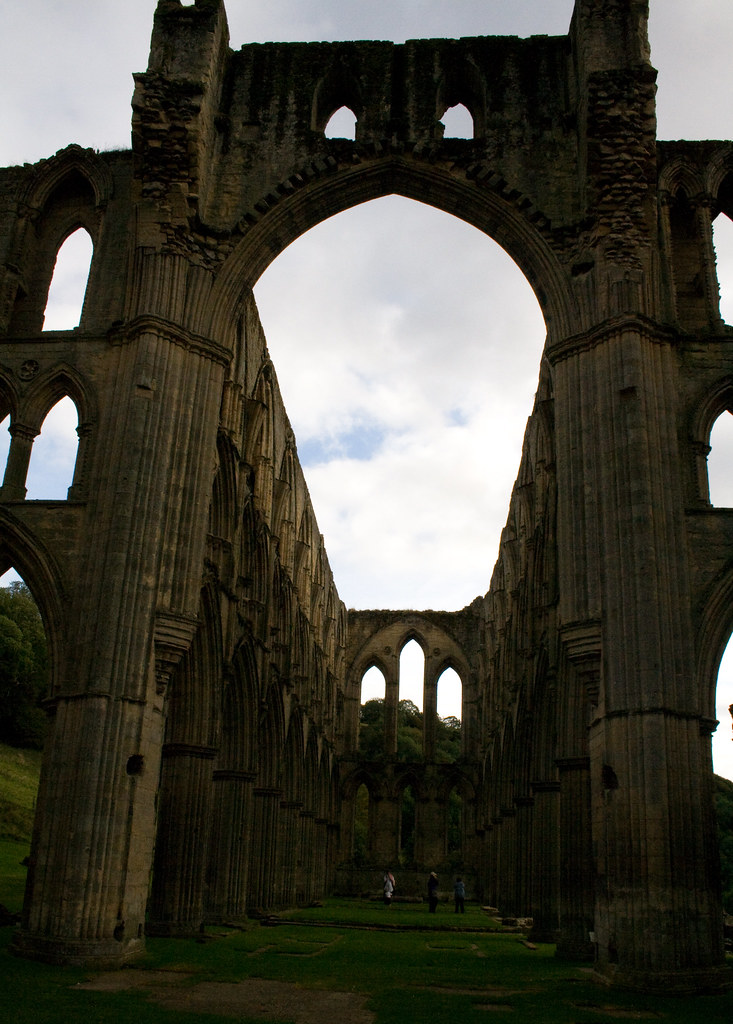
Rievaulx Abbey, Yorkshire, Cistercian (more photos).
Sociologists will tell you that isolation and persecution leads to radicalisation. This is the fervour which those looking forward to persecution are hoping for. But it can more easily be wrong-headed radicalisation which grows, rather than the admirable kind, in a situation where the institutions of Catholic education and informed debate have been destroyed.
An extraordinary air of whimsy and presumption pervades the air when persecution is discussed. Are the Catholics of today more ready for rack and rope than the Catholics of 1535 or 1939? I don't think so.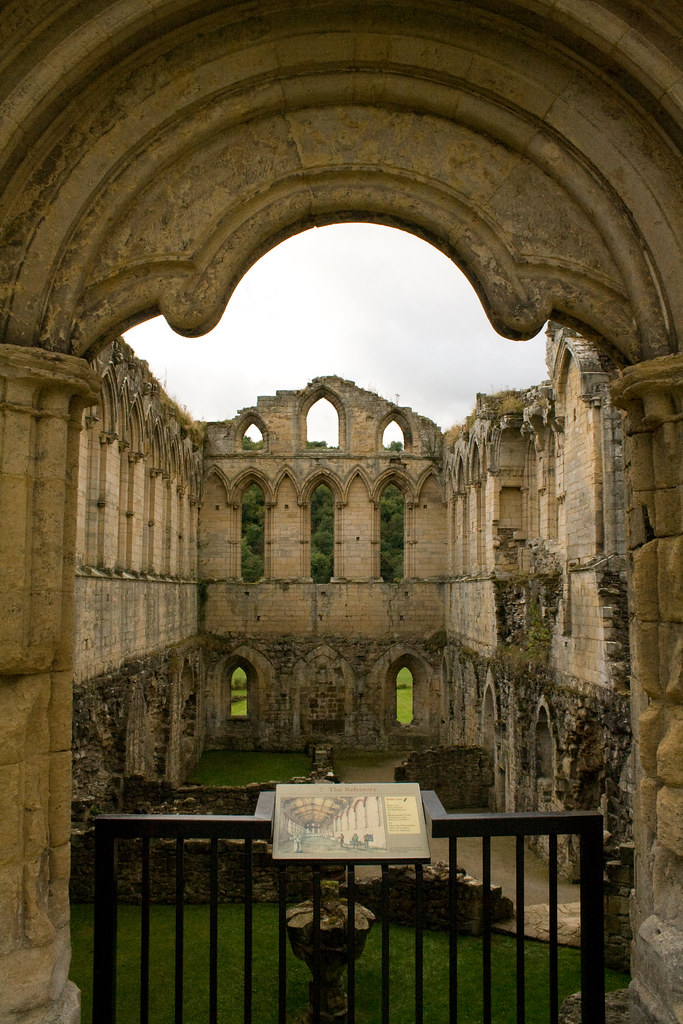
Rievaulx Abbey, Monks Refectory
Look at the last two pictures above: this is the achievement of St Aelred of Rievaulx, one of the greatest spiritual writers of his age, who created one of the greatest religious houses of England. What is it now? A pile of stones whose visitors scarcely know what God Aelred worshipped.
Appeal to Cardinals: text revealed
In light of the appearance of the signatories and the text of the Appeal to the Cardinals online, the organisers of the appeal are issuing a press release, below, for immediate release.
The appeal and its covering letter can conveniently be seen here.
I will be continuing to act as spokesman for the group, and will be happy to answer questions.
Dr Joseph Shaw
appealtothecardinals@gmail.com
Press release – Publication of theological critique and accompanying letter sent to the cardinals and patriarchs
The National Catholic Reporter of Kansas City, Missouri, recently published, without authorisation, the names of the signatories of a letter to the College of Cardinals and Eastern Patriarchs; equally without authorisation, The Australian, an Australia-based newspaper, has recently published the full text of the letter and the accompanying document. The latter is a theological critique of the apostolic exhortation Amoris laetitia, and requested that the cardinals and patriarchs petition Pope Francis to definitively and finally condemn certain propositions. In order to protect the signatories and the critique from misrepresentation, the organisers of these documents wish to offer some further comment and explanation of them.
As explained in previous statements, the organisers did not make these documents public, since they are addressed to the Cardinals and Patriarchs, who would ideally have been allowed to consider them without the distraction of public controversy over the documents.
The critique is the work of a number of Catholic scholars who were concerned that Catholics might understand some passages of Amoris laetitia as contradicting the doctrine of the Catholic faith. The remedy for this danger is an authoritative and final statement by the Supreme Pontiff stating that these understandings cannot be held by Catholics, and that Amoris laetitia does not present them as magisterial teachings or require that they be believed. The college of cardinals has the function of advising the Pope. The patriarchs of the Eastern Catholic churches also have the right and responsibility to advise the Supreme Pontiff on this matter in virtue of the importance of their office. Accordingly a document was drafted setting forth the gravest dangers of the text of Amoris laetitia and sent to the cardinals and patriarchs, along with a letter requesting them to petition the Pope to condemn the errors at issue.
The dangers to the faith found in passages of Amoris laetitia, in light of the ways they can be understood, are indicated by the application of theological censures. Theological censures are terms that identify the precise character of a threat to faith and morals that is found in an assertion. The various censures used in the document refer either to the gravity of the error found in a statement, or to the harmful effects that are liable to result from it. The censures in the critique are purely doctrinal and not juridical in nature, as the signatories do not claim or possess the authority necessary to impose juridical censures. They do not question the personal faith of Pope Francis or claim that he assents to the propositions censured. This is shown by the purpose of the document, which is to obtain a condemnation of these propositions by the Pope. The censures are intended to advise the cardinals and patriarchs, and their authority comes from the Scriptural and magisterial texts that are cited to justify them. Censures of this kind may be assigned by any person in the Church who has the knowledge, role, and mission needed to teach concerning questions of faith and morals.
The censures and the references given to justify them are based on the Catholic understanding of faith and divine revelation. According to this understanding, if a statement is proposed by the Church as requiring the assent of faith (the most authoritative level of teaching), that statement is not a human interpretation of a divine act or teaching, but is a statement made by God Himself. Such statements are formulated using languages and concepts belonging to human cultures, and are taught by the Church in particular historical circumstances. But these languages, concepts, and circumstances do not in any way alter or distort the truths that God asserts. They are used by all-powerful divine providence to express precisely the meaning that God intends to communicate. It is the signatories’ earnest hope and prayer that the cardinals and patriarchs will speak out against the errors that their critique addresses, and that the Holy Father will authoritatively condemn these errors.
ENDS
Support the work of the LMS by becoming an 'Anniversary Supporter'.
The Traditional Mass and Ecclesiology
Basil Loftus has circled back to his story about Cardinal Benelli in his latest column in the Catholic Times, so I thought I'd repost this response to it from April 2016
-------------------------------------
 |
| Giovanni, Cardinal Benelli |
Thanks to the archives of the FIUV, I can shed some light on something mentioned by Mgr Basil Loftus in a column I discussed the other day. He'd picked up the claim that Cardinal Benelli had once said to the President of the Una Voce Federation (FIUV), Dr Eric de Savanthem, that there was a connection between the Traditional Mass and ecclesiology. (Contrary to Loftus, Benelli was actually made a cardinal the year after this meeting, in 1977.)
I noted that Lofus didn't cite a source for this: when one realises what his source is, it is easy to see why he'd rather his readers didn't know. Here is a longer extract: I've emboldened the words quoted verbatim by Loftus to the hapless readers of the Catholic Times on 27th March.
When the President of Una Voce at an interview with Archbishop (now Cardinal) Benelli in Rome in October 1976, pointed out the existing liturgical chaos and asked how, in view of this state of things, the suppression of the old Mass could be justified, he was told that “those who wish to retain the old Mass have a different ecclesiology.” This from one of the closest advisors of the then Pope; it meant that those who were faithful to Catholic tradition were now to be treated as dissidents. The phrase quod semper, quod ubique, quod ab omnibus (“What has been believed always, everywhere, and by all”) as a criterion of orthodoxy bad now been rejected in favor of a new Party Line which contradicted the Church’s entire previous tradition. What was forbidden and condemned yesterday becomes lawful today, and mandatory tomorrow. What had always been seen as black, is now white, and vice versa─because the Party says so. This comes close to the Bolshevik criterion of morality: what is right or wrong is simply what helps or hinders the Party.(Source: SSPX USA District)
This is an old article (first published in 1982) by a certain Fr. Wrighton. It is easy to see why the SSPX might want to make this point, and it has often been noted that radical liberals have something in common with the more radical proponents of tradition, in stressing the discontinuity between before and after the Council. What I've never seen before is a liberal actually using verbatim arguments from what they claim are their most extreme opponents, to make this point. Unlike the SSPX, however, Loftus is embracing a position whose implications he cannot deal with. Because if there really is this discontinuity, he cannot go on to claim that traditionally-minded Catholics should submit to every jot and tittle of the new regime, because, on his analysis, the new regime has no genuine authority, and in any case he doesn't accept its authority himself. If every Pope up to 1962 was a fool and even a heretic, there is absolutely no reason to pay any attention to the Popes since 1962, any more than Loftus does in fact pay attention to the Pope Paul VI's teaching on contraception or Pope Benedict's promulgation of the new English translation of the OF Missal.
However, Fr Wrighton and Mgr Loftus has both got the wrong end of the stick. As I have discovered, Cardinal Benelli's argument wasn't that theology embedded in the Old Mass had been overturned by Vatican II. It was rather that the desire for the Old Mass when the Holy Father does not want you to desire it is wrong.
Here is an extract from Eric de Savanthem's own summary of the interview, in a letter which he sent to Benelli after it took place. This letter and subsequent correspondence was later circulated to members of the FIUV. The date of the letter (not the meeting) is 26th October 1976; the emphasis is mine.
Your Excellency has urged us to espouse as a matter of conscience the new forms of the Church's public cult, promulgated in the course of these last years by "the Apostolic See and the episcopal conferences, under the authority of the Holy Father conferred by Christ". You have reminded us of Our Lord's words; "What you shall bind on earth shall be bound in heaven", "Graze my sheep", "Confirm your brethren", and you insisted on the point that, for the government of the Church, Christ had given to Peter and to his successors a "charisma" which is to be considered as a gift both unique and indivisible. Although the character of irreformability only attaches to definitions, promulgated ex cathedra in matters of faith and morals, the assent due to the acts of the Sovereign Pontiff ought equally to express itself in humble obedience to those of his acts which merely concern the discipline or other nondoctrinal aspects of the government of the Church. For there also, you said, it is the same one and indivisible charisma which guarantees that all these acts cannot but be ordered towards the true and certain good of the Church. Consequently, you could only consider as reckless and irreconcilable with a proper ecclesiology all demands or initiatives which implied that the utility of such and such an act of government duly promulgated by the reigning Pontiff or under his authority could be a subject of discussion or even contestation.
Cardinal Benelli does not dispute the accuracy of this summary in his response. What it amounts to - as Dr de Savanthem goes on to explain at some length, though not in these terms - is an extreme Ultramontanism, the view that imbues the reigning Pope's prudential decisions with something close to infallibility, and his wishes with a force approaching that of Divine Law. As Benelli explains in his response to de Savanthem:
You reiterate unceasingly the same arguments to withhold in effect compliance with that which is clearly wanted by the Church and by the Holy Father himself: the loyal and trusting adoption, by all the faithful of the Roman Rite, of the rite reformed under his authority and in application of the orientations laid down by the Council.
'The Holy Father wishes it!' Then, it would seem, the matter is closed.
Can liberals use this criticism of de Savanthem and the FIUV back in 1976 as a stick to beat us with? Hardly. Loftus can't bring himself to accept the authority of the Pope when it is applied to matters which are quite genuinely within its purview, as I've already noted. There is no question of him and his like of accepting liturgical legislation, like the new English translation of the OF Missal, not only as binding, but even as ruling out any further discussion.
The liberals take an extreme position in rejecting the authority of the Pope and the Church - except in the most opportunistic and inconsistent manner, as when Loftus criticises Pope Benedict for not following the norm of the General Instruction of the Roman Missal which says nothing on the Altar should impede the congregation's view.
Some neo-conservatives take an opposite extreme position, in extending the authority of the Pope to absurd lengths, and Benelli's authoritarianism is an example of this.
Catholics attached to the Church's traditions have long upheld the only sensible position: that the authority of the Holy See is real, but has its limitations. We aren't bound to believe everything the Pope says, when it isn't framed as teaching of the Church, nor are we bound to do everything he wishes, when his wishes are not promulgated as canonical obligations. But when he does exercise his authority, then that must be accepted. As I pointed out when addressing a similar argument from the progressive liturgist and composer of ghastly hymns, Paul Inwood, even when there may be some ambiguity, as there long was over the legal status of the Traditional Mass, the policy of the FIUV and the Latin Mass Society alike was not to throw caution to the winds and do what we wanted, but with reason and respect to make the case for our position, and humbly but insistently seek the necessary clarification.
That is what finally happened, in 1988, when Pope St John Paul II confounded authoritarian neo-conservative successors of Benelli (who had died in 1982) by saying that the desire for the Traditional Mass was a 'rightful aspiration'. It happened again in 2007, when Pope Benedict XVI revealed that the 1962 Missal had never been abrogated.
What bitter days those must have been for Ultramontanists who had been insisting on he contrary positions, on the basis of an inflated understanding of Papal authority: to be contradicted by the reigning Pope! But that is always the risk when you pin everything to the lightest words of the Holy Father. Words lightly spoken can be lightly contradicted by the speaker, or his successor. That's a lesson some conservatives have still to learn.
Support the work of the LMS by becoming an 'Anniversary Supporter'.
Reports of my death are premature
As Mark Twain said.
Seriously, how do they work these things out?
In case you were wondering, I wasn't born in Lancashire either - and certainly not in 1920. And nor is my wife called ... Well, you get the idea.
Support the work of the LMS by becoming an 'Anniversary Supporter'.
Advance notice: Vespers of All Souls in Warwick Street
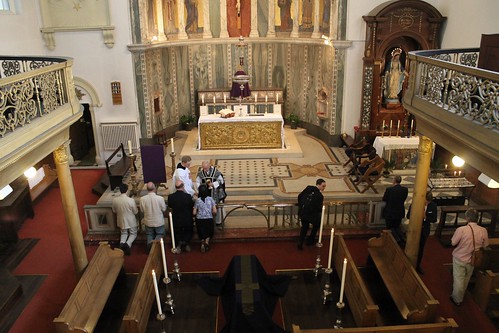 |
| Requiem for Michael Davies organised by the LMS last year, in Our Lady of the Assumption, Warwick Street. The celebrant was Fr Tim Finigan. |
Fr Mark Elliot Smith will officiate.
5:30pm, Wednesday 2nd November (All Souls Day)
Our Lady of the Assumption, Warwick Street, W1B 5LZ
Latin Vespers of the Dead, with polyphony (Viadana and Palestrina)
A new editor for Mass of Ages

The forthcoming edition of Mass of Ages, the magazine of the Latin Mass Society, will be the last edited by Dylan Parry. It has been great working with him, for sadly too short a time, but we cannot regret his reason for moving on: a desire to test a vocation to the religious life. He will be leaving his editorial position at Oremus, Westminster Cathedral's magazine, at the same time.
The LMS has appointed Tom Quinn as Managing Editor of Mass of Ages magazine. Based in London, Tom comes to his new role with many years’ experience behind him as an editor, photographer and writer. He has worked on magazines covering a variety of subjects, as well as contributing to mainstream newspapers. With this wealth of experience, and being a Catholic who has knowledge and enormous sympathy for traditional practices, he is suitably qualified to build on the very successful work done by Dylan Parry, our outgoing Managing Editor.
Dylan leaves us to test a vocation to the Religious Life. The next edition of Mass of Ages, due out in August, will be his last and we take this opportunity to thank Dylan for his work in making Mass of Ages appeal to an ever-increasing readership and assure him of our prayers.
Joseph Shaw, Chairman of the Latin Mass Society, said, 'The Society is very grateful to Dylan for his work on the magazine, and we assure him of our prayers for his novitiate. We are very fortunate to have found such an experienced and highly skilled replacement in Tom Quinn, and look forward to working with him.'
Support the work of the LMS by becoming an 'Anniversary Supporter'.
Anthea Craigmyle: In paradisum deducant te Angeli.
The rather odd-looking chapel is a municipal mortuary chapel, in Chiswick New Cemetry. Although designed with a rather different kind of liturgy in mind, we were able to have the Traditional Mass there without serious difficulty. Although we only managed to fit two candlesticks on the tiny altar.
In paradisum deducant te angeli: in tuo adventu suscipiant te martyres, et perducant te in civitatem sanctam Ierusalem. Chorus angelorum te suscipiat, et cum Lazaro, quondam paupere, aeternam habeas requiem.
May the angels lead you into paradise: may the martyrs receive you at your coming, and lead you into the holy city, Jerusalem. May the choir of angels receive you, and with Lazarus, who once was poor, may you have everlasting rest.
Support the work of the LMS by becoming an 'Anniversary Supporter'.
Reform of the Reform: a brief reply to Fr Hugh
Fr Hugh Somerville-Knapman has done me the honour of replying to my post on the fall-out from the Sacra Liturgia conference. At the risk of appearing engaged in too incestuous a discussion - Fr Hugh is an old friend and fellow student and I've had a similar discussion with him on this blog before - I wanted to pick up on a couple of his points.
First, I should apologise for the offence I've caused; I did get a little carried away. I don't mean to impugn the good intentions of people like Fr Hugh who promote the Reform of the Reform, and indeed I did try to explain the reasoning behind their position in in a sympathetic way.
Second, I should say to Fr Hugh that I certainly didn't have his blog in my sights when I talked about the damage caused by the hype over Cardinal Sarah's words. His blog, like mine, is not, I fancy, primarily responsible for the way things are perceived in Rome, Washington DC, or Archbishop's House in Westminster. I had more in mind banner headlines in the Catholic Herald.
But to business. Fr Hugh makes a surprising assertion about my position. He writes:
Yet, if the full restoration of pre-conciliar worship is the goal, how to achieve it? By fiat, an imposition on the Church as violent as that in 1969 which made mandatory a Mass that few if any laity were really prepared for?
The answer to that rhetorical question is 'Obviously not', but Fr Hugh appears to imagine that I think the answer is 'Yes', and goes on to criticise me quite harshly for a proposal I have never made, never intend to make, and do not agree with. Indeed, I thought the tenor of my post was clear enough: that I envisage progress (at any rate for the foreseeable future) as nothing more than the organic growth of the celebration of the Traditional Mass, a continuation of the progress it has made particularly since 2007.
That is just a misunderstanding. More substantively, Fr Hugh reacts to my criticism of the tactical blunder of the Sacra Liturgia conference people in a somewhat confusing way. What I had said was that the volume of hype forced Cardinal Nichols, Fr Lombardi, and others to react publicly: that is, it made them feel they had to react. This seems undeniable, since they didn't react in this way on the previous occasions Cardinal Sarah has made his point about the desireability of celebration ad orientem, as he did in an interview back in May.
Fr Hugh wants to have this both ways. First, yes there was nothing in the Cardinal's remarks which justified the reaction, because there was nothing very new or startling about them; but at the same time they were worthy of the hype because they were new and startling after all.
Well, whatever you say Fr. The point remains that the reaction came because the remarks were being presented (hyped) as significant, and in the present situation in the Church the reaction was, if not completely predictable, at least very likely. The saddest thing in the whole sorry story is Fr Hugh's assertion, which I am sure is true:
'the organisers did not have any expectation of response'
The Sacra Liturgia Conference has set the cause of the Reform of the Reform back by 20 years. That may not be a bad thing.
The reactions to Cardinal Sarah's words encouraging celebration of Mass 'ad orientem', with the priest facing east as the congregation does, continue to reverberate. In addition to a 'clarification' by the Vatican spokesman, Fr Lombardi, and a letter from Cardinal Nichols to the priests of Westminster Diocese, we have now had a letter from the Chairman of the relevant committee of the US Bishops' conference. All these statements point out that Cardinal Sarah's comments do not change liturgical law, and in slightly different ways claim that the current law favours celebration 'versus populum,' with the priest facing the people. The US letter asserts that a decision to change from vs. pop. to ad orientem celebration by a priest should only be done with the knowledge and approval of the bishop.
None of these statements, any more that Cardinal Sarah's, have in themselves the force of law. Nevertheless, they make public, clear, and official, a view which was up to now not so public, not so clear, and not so official: that celebration vs. pop. is officially favoured to the point that celebrating ad orientem needs, at least, special justification.
The kind of initiatives in which the 'Reform of the Reform' (RotR) consists, at the local level, depend on a degree of ambiguity about what is allowed or favoured by the rules. Such ambiguity abounds in official documents. Are altar girls permitted or actually favoured? Female lectors? Communion under both kinds? The use of the Roman Canon? Silent recitation of the Offertory? The sign of peace? Concelebration? The debate about the rules (unlike the debate on the underlying theology) is not only endless, but both exceedingly boring and ultimately pointless. It suffices that conservative and liberal priests alike can claim a degree of leeway and, when the pastoral and political conditions permit, quietly move things in their favoured direction. The golden rule in such matters is that you don't press for clarification unless you are sure things will be clarified in your favour.
This is the rule apparently forgotten by the organisers of the Sacra Liturgia conference, and their friends in the Catholic media, both on and offline. I certainly don't attribute any blame to Cardinal Sarah, who said nothing more in London than what he has said, without any bad results, on the record before, and, if anything, less than what Cardinal Ratzinger said in the Spirit of the Liturgy in 2000 and Cardinal Schonborn said in a retreat he preached to Pope St John Paul II in the mid 1990s (it was published as 'Loving the Church' in 1996). The problem lay in the hype heaped on his words by others. Not only was the hype false - as just noted there wasn't anything new or big about what he said - but it meant that Cardinal Nichols, Fr Lombardi, and all the others felt that they had to respond. And what sort of response did the organisers imagine they would get? What sort of official atmosphere do they imagine pertains in the Church right now? Where, in heavens' name, have they been for the last few years?
It is this which has put the cause of the Reform of the Reform back by twenty years - back before Cardinal Schonborn's cautiously worded but carefully argued and impassioned plea for worship 'obviam sponso', 'facing the bridegroom', twenty years ago. Is it conceivable, now that Fr Lombardi has nailed the Holy See's colours to the mast, that such an argument could be made in the presence of the Holy Father now? I don't think so either.
Behind this tactical blunder lies a more fundamental strategic mistake. The organisers of the Sacra Liturgia conference were keen to present the whole thing as about the Reform of the Reform rather than about the promotion of the Traditional Mass. The Traditional Mass was included just as part of the Church's rich pattern, and not as in any way a key element. The idea is that too-obvious association with the EF is politically disadvantageous: it is safer to present oneself as wanting to tinker with the (when properly understood, wonderful wonderful) liturgical reform, rather than as rejecting it.
The argument would seem to make sense, but people have been making it ever since the Novus Ordo Missae appeared in 1969, and it has never worked. The first problem is that the things the RotR people want, particularly celebration ad orientem, are interpreted as a de facto rejection of the reform as a whole by overwhelming powerful forces in the Church. I noted in a previous post that this view has its own logic; for present purposes it suffices to note that it is not going away. An auxiliary consideration is that it is suspected, with perfect justice, that many RotR advocates actually want the Traditional Mass anyway.
The second aspect of the mistake is that the Traditional Mass is not today seen as a poisonous, problematic thing at an official level in the Church. Although a much more radical departure from the reformed Mass than RotR ideas, it is treated much more leniently. Cardinal Nichols doesn't fancy his priests celebrating the OF ad orientem, but asked two of them to learn the EF to expand Sunday provision for it in his diocese. Religious Institutes committed to the Traditional Mass are welcomed into dioceses all over England, the USA, and indeed the world, by bishops who are never going to get rid of Altar Girls, Eucharistic Prayer 2, or communion in the hand, in the Ordinary Form.
The reason is not difficult to understand. The Reform of the Reform has the potential, if widely taken up, to turn dozens of parishes into liturgical war zones. Priests who take a stand on any of the major RotR issues can expect confrontations with parishioners with complaints going to the Bishop. People walk out of Mass; there are shouting matches. The development of the Traditional Mass in a diocese works in a completely different way. Here a bishop saves a historic church by giving it to a traditional Institute. There a priest introduces an extra Mass into his timetable for a handful of parishioners. People might complain but the complaints are obviously unreasonable, since it doesn't affect their own spiritual lives. No one need walk out of his favoured Mass never to return. No one has had his spiritual peace shattered. But in the meantime these initiatives have the potential to grow. They draw in the lapsed, they foster vocations. We don't pull down; we build up.
Hard-core RotR advocates will tell us that this is no way to restore the Church. They say we have to 'save' the OF because that is what nearly all Catholics attend. They like to imagine that celebration ad orientem could be rolled out in dozens of parishes in a short time, and that it would be a huge step forward. I don't disagree with the theological arguments they advance; I would just like to point out the real world - that annoying thing which gets in the way of so many fine theories. In this real world, which I at least am condemned to inhabit, this plan is not working. What is working is the steady advance of the Traditional Mass, which give people not a peculiar compromise liturgy, but a coherent liturgical and spiritual life.
There is something else as well. I don't bring to this debate many decades of personal experience. But I have already seen one of the consequences of the Reform of the Reform movement which its advocates are not so keen to advertise. That is sincere and zealous priests having nervous breakdowns. I apologise for putting it here in black and white, but it is something we should face. If you are telling priests to adopt a plan of action, you need to think through the consequences. Putting priests into massive unavoidable conflict has predictable results. Many priests have told us of the spiritual consolations accorded to them by learning and saying, even if only in private, the Traditional Mass. This is something which we can help them do which will be good for them, and if good for them then good for their parishes. Having arguments with Tablet-reading members of the parish liturgy committee does not pack the same spiritual punch.
So perhaps it is not such a bad thing, all things considered, that the cause of the Reform of the Reform has been set back by twenty years.
Support the work of the LMS by becoming an 'Anniversary Supporter'.

